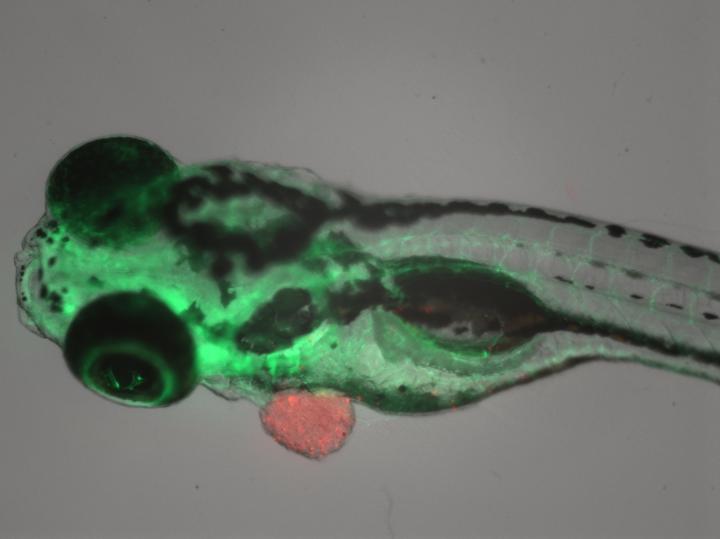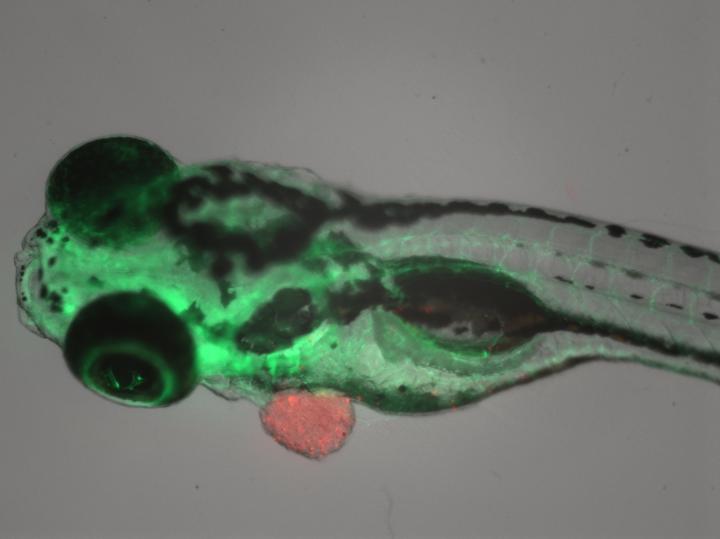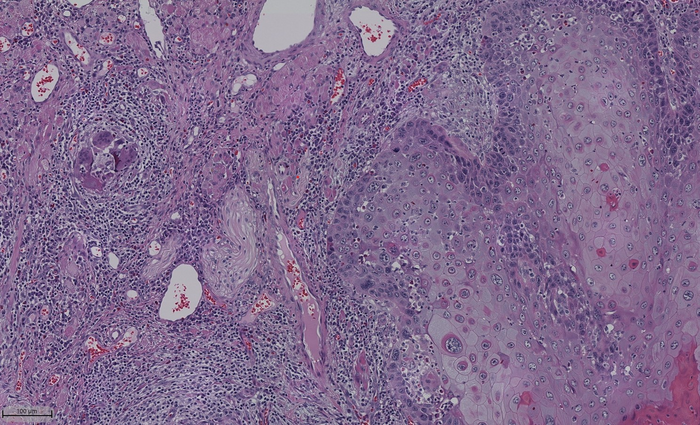
Credit: Rita Fior/CCU
Portuguese scientists have for the first time shown that the larvae of a tiny fish could one day become the preferred model for predicting, in advance, the response of human malignant tumors to the various therapeutic drugs used to fight cancer. If the results of this study, led by two scientists from the Champalimaud Centre for the Unknown (CCU), in Lisbon, Portugal, are confirmed, it should be possible to readily and safely choose the most efficient treatment for each patient. The study will be published online in the August 21, 2017 "early edition" of the journal Proceedings of the National Academy of Sciences (PNAS).
Currently, the efficacy of a given anticancer chemotherapy is generally not tested at a personalized level. Drug treatments are "prescribed" by taking into account the success rates obtained in clinical trials involving many patients. Personalized tests, which consist in transplanting human tumoral cells into mice, can only be performed in large hospitals and cancer centers.
Mice are mammals, so they are close to us in biological terms, and the tumor's response to a drug in the mouse is predictive of its behavior in the patient. However, this is a very long process, and does not give timely answers (the tumor takes months to grow in the mouse).
On the other hand, if zebrafish larvae turn out to be a good model for these tests, it becomes possible to determine, in less than two weeks, which is the best chemotherapy to be used in each case, conclude Rita Fior, Miguel Godinho Ferreira and their colleagues.
Previous studies had shown that these tiny aquatic animals could actually be a good model for human pharmacology. And the preliminary results now published by the Portuguese team are there to show it: "We demonstrated for the first time that zebrafish and mice react to treatments in the same way: with the same drugs, we obtain the same results in mice and in zebrafish larvae", explains Miguel Godinho Ferreira.
The story of an idea
It all started in 2013 at the Instituto Gulbenkian de Ciência (IGC) in Oeiras, near Lisbon, when a common colleague advised Rita Fior and Miguel Godinho Ferreira to talk to each other, because she realized that they were both thinking along the same lines. Both were – and are – doing basic research, but both wanted "to be able to help people right away", as Miguel Godinho Ferreira puts it.
Rita Fior, who specialized in developmental biology, studies zebrafish. And she says she was always "very frustrated about the fact although we have so much technology, we can put people on the moon etc., if someone has a tumor we still don't know which drug is best for that specific tumor, within the several approved therapeutic options".
Miguel Godinho Ferreira, who is interested in the evolution of tumors, says: "my main concern has been, for a long time, the fact that tumors change". Not only is it known that malignant tumors can be very heterogeneous – which means chemotherapy will not work against all its cells -, but also that tumors evolve with time. This makes it all the more difficult to choose the right chemotherapy. "In some cases, the efficacy rate of chemotherapies can be low, sometimes around 35%", adds Miguel Godinho Ferreira. "This means that some patients risk taking inadequate drugs that weaken them – and without a proper test, there is no way to know who will benefit and who won't."
Back to the story. During one of their first conversations, the two scientists agreed on a common goal: transplanting human tumoral cells directly into zebrafish larvae, without first growing them in the lab (a process which also alters the cells). Their idea was to simulate the tumor in the larvae in the most similar way possible to what actually happens in the person's body.
The project elicited a degree of skepticism, but at the time, Miguel Godinho Ferreira was selected as a Howard Hughes Medical Institute (HHMI) international early research scientist. "The HHMI had given me money to do research on non-mainstream ideas, and I could also ask whoever I wanted to work with me", he recalls.
During its first year, the project was based at the IGC. But Miguel Godinho Ferreira was already in contact with the CCU – where, given the specialization on cancer of its Clinical Centre and focus on research, they would profit from the best environment to take their assay to patients undergoing therapy.
"The Champalimaud Foundation nurtured the project because of its translational potential [the transposition of basic research to clinical application] and promised us financial support", he points out.
Rita Fior and her colleagues arrived to the CCU in 2014, where having the lab was right next to the anatomical pathology service of the clinical center (where patient biopsies are analysed) and gaining access to the hospital pharmacy were of extreme importance to launch a more advanced phase of the project.
This has allowed her to become totally integrated in the hospital circuits, transplanting into the larvae fragments of a patient's tumor and using on the fish exactly the same chemotherapy protocols that are given to that patient. "The drugs Rita tests on the larvae are what remains of the treatment received by the patient, which would normally be returned to the pharmacy and discarded", says Miguel Godinho Ferreira (who currently also works at the IGC).
Five patients
Results followed from there. As the team – which includes clinicians and pathologists – write in their paper, they discovered that the fish model had sufficient resolution to detect different treatment requirements even in very genetically similar tumors. Furthermore, they confirmed that it took a single mutation in a gene called RAS – which is known for frequently being altered in cancerous tumors – to change a tumor's response to a treatment. "We obtained an incredible resolution power", says Miguel Godinho Ferreira, "a sensitivity at the allele level [an allele is a variant of a given gene]!"
"There were some previous independent studies on this type of approach in the zebrafish", explains Rita Fior. "What is new in our work is that we challenged the model to see if it could detect even small differences, screened the available therapeutic options to test their efficacy, compared fish with mouse and then did proof-of-concept experiments using patient samples."
In the last part of their work, the scientists did a preliminary study of the predictions supplied by the "avatars" for five patients. "We transplanted into the fish tumoral masses from five patients with colorectal cancer being treated either at the Champalimaud Clinical Centre or at the Amadora-Sintra Hospital", a large public hospital in the outskirts of Lisbon, specifies Rita Fior.
Following surgery, colorectal cancer patients are usually given chemotherapy to reduce the probability of relapse. And what the scientists did was to submit the avatars of those five patients to the same chemotherapy and then compare the response to the treatment in the fish and the person.
"For two of the patients, the tumors transplanted into the larvae did not respond to the chosen chemotherapy", adds Rita Fior. "And in fact, consistent with our results, a short time afterwards those patients relapsed." On the other hand, two other patients whose avatars responded to the treatment "are still doing well as far as we know", says Miguel Godinho Ferreira. To summarize: in this small study, the avatars gave the correct answer in four out of five cases.
The next phase will consist in doing the same type of comparisons in hundreds of patients to confirm the test's predictive power, which can take around two years to complete. "If everything goes well, we will be able to inform oncologists on the result of the different therapies in the avatars; they will always have the final word in terms of deciding which therapy to choose, but they will be able to base themselves on individual tests", says Miguel Godinho Ferreira.
"Our dream", he concludes, "is to develop an 'antibiogram' for cancer. Just as we currently do this today for bacterial infections, we hope to obtain a kind of matrix for each patient of the efficacy of the various drugs that will allow physicians to choose the most indicated therapy for each person."
###
Media Contact
Maria Joao Soares
[email protected]
http://www.fchampalimaud.org/






